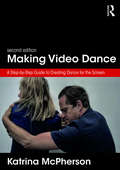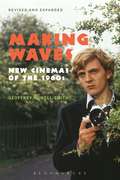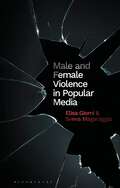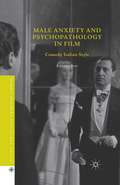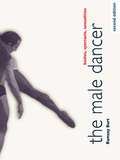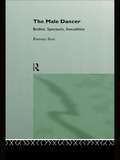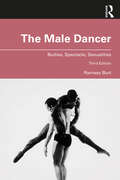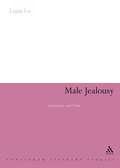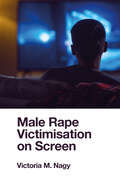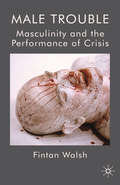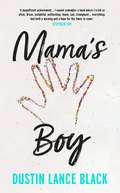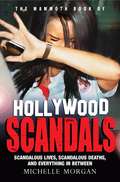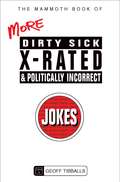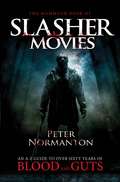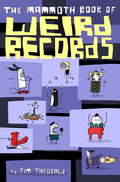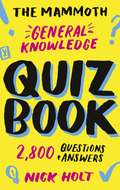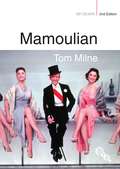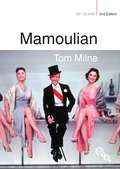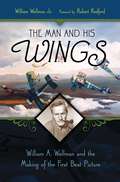- Table View
- List View
Making Video Dance: A Step-by-Step Guide to Creating Dance for the Screen (2nd ed)
by Katrina McPhersonMaking Video Dance: A Step-by-Step Guide to Creating Dance for the Screen is the first workbook to follow the entire process of video dance production: from having an idea, through to choreographing for the screen, filming and editing, and distribution. In doing so, it explores and analyses the creative, practical, technical, and aesthetic issues that arise when making screen dance. This rigorously revised edition brings the book fully up to date from a technical and aesthetic point of view, and includes: An extended exploration of improvisation in the video dance-making process New writing about filming in the landscape Additional writing on developing a practice and working with scores and manifestos Updated information about camera use, including filming with mobile phones A step-by-step guide to digital non-linear editing of screen dance Ideas for distribution in the 21st century Insights into Katrina’s own screen dance practice, with reference to specific works that she has directed and which are available to view online New and revised practical exercises New illustrations specially drawn for this edition
Making Waves, Revised and Expanded: New Cinemas of the 1960s
by Geoffrey Nowell-SmithThe 1960s was famously the decade of sex, drugs and rock'n'roll. It was also a decade of revolution and counter-revolution, of the Cuban missile crisis, of the American intervention in Vietnam, of economic booms and the beginning of consumerism (and the rebellion against it). In Hollywood, the genres which had held audiences captive in the 1940s and 50s - musicals, Westerns, melodramas - were losing their appeal and their great practitioners were approaching retirement. The scene was therefore set for new cinemas to emerge to attract the young, the discriminating, the politically conscious and the sexually emancipated.Making Waves, Revised and Expanded is a sharp, focused, and brilliant survey of the innovative filmmaking of the 1960s, placing it in its political, economic, cultural and aesthetic context - capturing the distinctiveness of a decade which was great for the cinema and for the world at large. Geoffrey Nowell-Smith pays particular attention to a handful of the most remarkable talents (Godard, Antonioni, Oshima) that emerged during the period and helped to make it so special. Nowell-Smith updates his classic text with a focus on 1960s Japan and the burgeoning New York scene.
Making Waves, Revised and Expanded: New Cinemas of the 1960s
by Geoffrey Nowell-SmithThe 1960s was famously the decade of sex, drugs and rock'n'roll. It was also a decade of revolution and counter-revolution, of the Cuban missile crisis, of the American intervention in Vietnam, of economic booms and the beginning of consumerism (and the rebellion against it). In Hollywood, the genres which had held audiences captive in the 1940s and 50s - musicals, Westerns, melodramas - were losing their appeal and their great practitioners were approaching retirement. The scene was therefore set for new cinemas to emerge to attract the young, the discriminating, the politically conscious and the sexually emancipated.Making Waves, Revised and Expanded is a sharp, focused, and brilliant survey of the innovative filmmaking of the 1960s, placing it in its political, economic, cultural and aesthetic context - capturing the distinctiveness of a decade which was great for the cinema and for the world at large. Geoffrey Nowell-Smith pays particular attention to a handful of the most remarkable talents (Godard, Antonioni, Oshima) that emerged during the period and helped to make it so special. Nowell-Smith updates his classic text with a focus on 1960s Japan and the burgeoning New York scene.
Male and Female Violence in Popular Media (Library of Gender and Popular Culture)
by Elisa Giomi Sveva MagaraggiaMale and Female Violence in Popular Media brings into focus the apparently symmetrical phenomena of men's violence against women and women's violence against men, explaining the profound differences in their actual features as well as in their representations, which over the last few years have been proliferating in a vast array of global media contents. Elisa Giomi and Sveva Magaraggia consider popular media including crime TV series such as The Killing (Denmark, 2007- 2012), The Fall (UK, 2013-2016) and True Detective (USA, 2015), factual entertainment such as Who the (bleep) Did I Marry? (Investigation Discovery, 2010-2015), and Italian pop music in order to examine popular culture's depictions of men and women in their opposite, yet complementary, roles of perpetrators and victims. They reveal how TV shows, pop-songs, news and commercials that populate global audiences' daily life fuel false beliefs about love and sexuality that either legitimate or stigmatise violence depending on the perpetrators and victims' gender.
Male and Female Violence in Popular Media (Library of Gender and Popular Culture)
by Elisa Giomi Sveva MagaraggiaMale and Female Violence in Popular Media brings into focus the apparently symmetrical phenomena of men's violence against women and women's violence against men, explaining the profound differences in their actual features as well as in their representations, which over the last few years have been proliferating in a vast array of global media contents. Elisa Giomi and Sveva Magaraggia consider popular media including crime TV series such as The Killing (Denmark, 2007- 2012), The Fall (UK, 2013-2016) and True Detective (USA, 2015), factual entertainment such as Who the (bleep) Did I Marry? (Investigation Discovery, 2010-2015), and Italian pop music in order to examine popular culture's depictions of men and women in their opposite, yet complementary, roles of perpetrators and victims. They reveal how TV shows, pop-songs, news and commercials that populate global audiences' daily life fuel false beliefs about love and sexuality that either legitimate or stigmatise violence depending on the perpetrators and victims' gender.
Male Anxiety and Psychopathology in Film: Comedy Italian Style (Italian and Italian American Studies)
by Andrea BiniThe most popular film genre during the golden years of Italian cinema, the Comedy Italian Style emerged after the fall of the Facist regime, narrating the identity crisis of many Italian men. Exploring the birth, growth, and decline of this genre, Bini shows this notable style was the search for a new role in the shattered postwar middle class.
The Male Dancer: Bodies, Spectacle, Sexualities
by Ramsay BurtIn this challenging and lively book, Burt examines the representation of masculinity in twentieth century dance. The Male Dancer has proven to be essential reading for anyone interested in dance and the cultural construction of gender.
The Male Dancer: Bodies, Spectacle, Sexualities
by Ramsay BurtIn this challenging and lively book, Burt examines the representation of masculinity in twentieth century dance. The Male Dancer has proven to be essential reading for anyone interested in dance and the cultural construction of gender.
The Male Dancer: Bodies, Spectacle and Sexuality
by Ramsay BurtIn this challenging and lively book, Ramsay Burt examines the representation of masculinity in twentieth century dance. Taking issue with formalist and modernist accounts of dance, which dismiss gender and sexuality as irrelevant, he argues that prejudices against male dancers are rooted in our ideas about the male body and male behaviour. Building upon ideas about the gendered gaze developed by film and feminist theorists, Ramsay Burt provides a provocative theory of spectorship in dance. He uses this to examine the work of choreographers like Nijinsky, Graham, Bausch, while relating their dances to the social, political and artistic contexts in which they were produced. Within these re-readings, he identifies a distinction between institutionalised modernist dance which evokes an essentialist, heroic, `hypermasculinity'; one which is valorised with reference to nature, heterosexuality and religion, and radical, avant garde choreography which challenges and disrupts dominant ways of representing masculinity. The Male Dancer will be essential reading for anyone interested in dance and the cultural construction of gender.
The Male Dancer: Bodies, Spectacle and Sexuality
by Ramsay BurtIn this challenging and lively book, Ramsay Burt examines the representation of masculinity in twentieth century dance. Taking issue with formalist and modernist accounts of dance, which dismiss gender and sexuality as irrelevant, he argues that prejudices against male dancers are rooted in our ideas about the male body and male behaviour. Building upon ideas about the gendered gaze developed by film and feminist theorists, Ramsay Burt provides a provocative theory of spectorship in dance. He uses this to examine the work of choreographers like Nijinsky, Graham, Bausch, while relating their dances to the social, political and artistic contexts in which they were produced. Within these re-readings, he identifies a distinction between institutionalised modernist dance which evokes an essentialist, heroic, `hypermasculinity'; one which is valorised with reference to nature, heterosexuality and religion, and radical, avant garde choreography which challenges and disrupts dominant ways of representing masculinity. The Male Dancer will be essential reading for anyone interested in dance and the cultural construction of gender.
The Male Dancer: Bodies, Spectacle, Sexualities
by Ramsay BurtThis revised third edition of The Male Dancer updates and enlarges a seminal book that has established itself as the definitive study of the performance of masculinities in twentieth century modernist and contemporary choreography. In this authoritative and lively study, Ramsay Burt presents close readings of dance works from key moments of social and political change in the norms around gender and sexuality. The book’s argument that prejudices against male dancers are rooted in our ideas about the male body and behaviour has been extended to take into account recent interdisciplinary discussions about whiteness, intersectionality, disability studies, and female masculinities. As well as analysing works by canonical figures like Nijinsky, Graham, Cunningham, and Bausch, it also examines the work of lesser-known figures like Michio Ito and Eleo Pomare, as well as choreographers who have recently emerged internationally like Germaine Acogny and Trajal Harrell. The Male Dancer has proven to be essential reading for anyone interested in dance and the cultural representation of gender. By reflecting on the latest studies in theory, performance, and practice, Burt has thoroughly updated this important book to include dance works from the last ten years and has renewed its timeliness for the 2020s.
The Male Dancer: Bodies, Spectacle, Sexualities
by Ramsay BurtThis revised third edition of The Male Dancer updates and enlarges a seminal book that has established itself as the definitive study of the performance of masculinities in twentieth century modernist and contemporary choreography. In this authoritative and lively study, Ramsay Burt presents close readings of dance works from key moments of social and political change in the norms around gender and sexuality. The book’s argument that prejudices against male dancers are rooted in our ideas about the male body and behaviour has been extended to take into account recent interdisciplinary discussions about whiteness, intersectionality, disability studies, and female masculinities. As well as analysing works by canonical figures like Nijinsky, Graham, Cunningham, and Bausch, it also examines the work of lesser-known figures like Michio Ito and Eleo Pomare, as well as choreographers who have recently emerged internationally like Germaine Acogny and Trajal Harrell. The Male Dancer has proven to be essential reading for anyone interested in dance and the cultural representation of gender. By reflecting on the latest studies in theory, performance, and practice, Burt has thoroughly updated this important book to include dance works from the last ten years and has renewed its timeliness for the 2020s.
Male Jealousy: Literature and Film (Continuum Literary Studies)
by Louis LoMale Jealousy: Literature and Film is a critical and cultural theory-based study of male jealousy in western culture and its connections with paranoia. By tracing the meanings of jealousy and the representation of jealous men (married or unmarried, heterosexual or homosexual), Lo argues that jealousy is promoted within patriarchy and within what Derrida characterises as logocentricism, where to love is the desire to be loved, and where love cannot be guaranteed in any form of sexual relationship. Contrasting the difference between jealousy and its closely linked concept, envy, this book explores the economy of possession and its relationship to the body, and argues, controversially, that jealousy is an even more modern concept than envy. Informed by critical theory, engaging in particular with Derrida, Deleuze, Freud, Lacan and Kristeva, the study offers close readings of key works by Cervantes, Shakespeare, Proust, Buñuel, Vidor and Almodóvar, in which a spectrum of different forms of jealousy are portrayed.
Male Rape Victimisation on Screen
by Victoria M. NagyResearch has established that men are unlikely to report being victimised by sexual assault, often out of feelings of embarrassment, shame, fear, and emasculation. Critically examining how the rape of men and boys is represented in television and film, Male Rape Victimisation on Screen argues how presentations of male sexual assault in popular culture have reinforced rape myths associated with male victimisation, as well as the barriers of toxic masculinity that seethe beneath its surface. Employing a feminist and popular criminology framework, Victoria M. Nagy conducts a comprehensive analysis of a range of both adult and child television programmes and films from the past several decades to reveal how rape myths have pervaded popular culture. Turning to reality and the broader implications this has for men who are and are not victims of sexual violence, Nagy explores how knowledge gained from this research can feed into sexual violence prevention efforts and inform a necessary shift in our cultural mindset. Focusing on the under-researched area of male sexual assault, this book broaches cultural, criminology, gender, film, and media studies to reveal how seemingly harmless humour can infiltrate how we think about violent and victimising behaviours.
Male Rape Victimisation on Screen
by Victoria M. NagyResearch has established that men are unlikely to report being victimised by sexual assault, often out of feelings of embarrassment, shame, fear, and emasculation. Critically examining how the rape of men and boys is represented in television and film, Male Rape Victimisation on Screen argues how presentations of male sexual assault in popular culture have reinforced rape myths associated with male victimisation, as well as the barriers of toxic masculinity that seethe beneath its surface. Employing a feminist and popular criminology framework, Victoria M. Nagy conducts a comprehensive analysis of a range of both adult and child television programmes and films from the past several decades to reveal how rape myths have pervaded popular culture. Turning to reality and the broader implications this has for men who are and are not victims of sexual violence, Nagy explores how knowledge gained from this research can feed into sexual violence prevention efforts and inform a necessary shift in our cultural mindset. Focusing on the under-researched area of male sexual assault, this book broaches cultural, criminology, gender, film, and media studies to reveal how seemingly harmless humour can infiltrate how we think about violent and victimising behaviours.
Male Trouble: Masculinity and the Performance of Crisis
by F. WalshA rich analysis of the discourses and figurations of 'crisis masculinity' around the turn of the twenty-first century, working at the intersection of performance and cultural studies and looking at film, television, drama, performance art, visual art and street theatre.
Mama's Boy: A Memoir
by Dustin Lance Black'A magnificent achievement . . . I cannot remember a book where I cried so often. Brave, insightful, unflinching, funny, sad, triumphant . . . everything. And both a warning and a hope for the times to come' STEPHEN FRYDustin Lance Black wrote the Oscar-winning screenplay for Milk and helped overturn California's anti-gay marriage Proposition 8, but he grew up in a conservative Mormon household outside San Antonio, Texas. His mother, Anne, was raised in rural Louisiana, and contracted polio when she was two years old. She endured brutal surgeries, as well as braces and crutches for life, and was told that she would never have children or a family. Willfully defying expectations, she found salvation in an unlikely faith, raised three sons, and escaped the abuse and violence of two questionably devised Mormon marriages before finding love and an improbable career in the U.S. civil service.When Lance came out to his mother at twenty-one, he was already studying the arts instead of going on his Mormon mission. She derided his sexuality as a sinful choice and was terrified for his future. Mama's Boy explores what it took to remain a family despite such division-a journey that stretched from the steps of the U.S. Supreme Court to the woodsheds of East Texas. In the end, the rifts that have split a nation couldn't end this relationship that defined and inspired their remarkable lives. Mama's Boy is their story. It's a story of the noble quest for a plane higher than politics - one of family, foundations, turmoil, tragedy, elation, and love. It is a story needed now more than ever.'To outsiders, my mom and I should have been enemies. Our house should have been divided -- North vs South, red vs blue, conservative vs progressive, or however you want to put it. Instead, my mom and I fuelled each other. Her oil lit my lamp, and eventually mine lit hers. The tools I'd learned to wield growing up in her conservative, Christian, southern, military home were the same I'd used to wage battles that had taken me from a broken-down welfare apartment where gunfire sang me to sleep, to the biggest stages in the world, and to the front row of the United States Supreme Court to fight for LGBTQ equality.'
The Mammoth Book of Hollywood Scandals (Mammoth Books)
by Michelle MorganMurders, suicides, unexplained deaths, scandalous romances, illegitimate children, cover-ups, and more, from the 1920s to Hollywood's Golden Age in the 1960s and right up to the present day.It covers over 60 scandals including: The Roscoe 'Fatty' Arbuckle Scandal; Clark Gable's Baby Scandals; The Rape of Patricia Douglas; The Life and Death of Jean Harlow; The Sudden Death of James Dean; Marilyn Monroe's Mysterious Death; John Belushi Dies at the Chateau Marmont; Madonna's Hollywood Stalker; Hugh Grant's Hollywood Scandal; Winona Ryder Is Arrested For Shoplifting; The Brad Pitt, Jennifer Aniston and Angelina Jolie Love Triangle; The Tragic Life and Death of Anna Nicole Smith; The Life and Death of Michael Jackson; Arnold Schwarzenegger's Love Child; The Very Public Melt-Down of Charlie Sheen; The Rise and Fall of Whitney Houston; The Marriage of Tom Cruise and Katie Holmes and many, many more.
The Mammoth Book of More Dirty, Sick, X-Rated and Politically Incorrect Jokes (Mammoth Books #458)
by Geoff TibballsFunny, fearless and absolutely filthy-nearly 3,000 more uncensored, dirty, sick, and deeply politically incorrect jokes, covering just about every topic imaginable, from adultery to (sex in) Zoos, including an assortment of bad taste lists. A worthy, all-new follow-on to the first bestselling volume.
The Mammoth Book of Slasher Movies (Mammoth Books #409)
by Peter NormantonAn engrossing A-Z of over 60 gory years of slasher and splatter movies, from Danny Boyle's 28 Days Later to Lucio Fulci's Zombie Flesh Eaters. Here you will find the low-down on over 250 movies with entries from 23 different countries. The index, which includes every movie mentioned in the A-Z and accompanying notes, runs to 540 movies. The book includes the list of video nasties which the UK government attempted to ban.
The Mammoth Book Of Weird Records (Mammoth Books)
by Jim TheobaldEveryone’s heard of Usain Bolt, but how many people know about Dineka Maguire? Like Bolt, the Irish woman is a world record holder but in the rather lesser known sport of bog snorkelling. She is just one of the hundreds of unsung heroes featured in this book chronicling the people who go to bizarre lengths to break world records in the weirdest categories; people who devote hours of intense training to spitting dung, eating cockroaches, sniffing feet or tossing tuna in the hope of one day being recognised as the best in the world. This astonishing compendium of the weirdest, wackiest and most disgusting world records will amuse and astound in equal measure.Entries include:Longest ear hairFastest marathon while wearing a deep-sea diving suitFastest bog snorkellerFarthest distance skateboarding by a goatMost bees on bodyMost milk crates balanced on head Fastest 5-km run while dressed as a penguin and jugglingHeaviest airplane pulled with teethFastest shopping trolleyLongest backwards motorcycle rideMost stairs climbed by bicycleFastest 30 metres on a scooter by a dogFirst water-skiing squirrel
The Mammoth General Knowledge Quiz Book: 2,800 Questions and Answers
by Nick HoltA bumper collection of 2,800 questions and answers to test even the most ardent quiz fanatic.
Mamoulian (BFI Silver)
by Tom MilneThe great Armenian-American director Rouben Mamoulian (1897-1987) remains a favourite among film-makers, his films combining great technical originality with a uniquely poetic visual style. Mamoulian's technical innovations are evident from his first film, Applause (1923), in which he incorporated two separate soundtracks into one printing, thus overcoming the difficulty of sound levels which had frustrated the pioneer directors of 'talkies', and in Dr Jekyll and Mr Hyde (1931), in which he used synthetic sound painted directly onto the soundtrack. Such inventive solutions to film-making challenges were linked to Mamoulian's abiding sense of the magic of the cinema. Heused colour as a dramatic ingredient in the first three-strip Technicolour film, Becky Sharp (1935), and his musicals Summer Holiday (1948) and Silk Stockings (1957) were remarkable in their time for the way in which the dance was used to enhance the drama and to illuminate character. And for Garbo, in Queen Christina (1933) he created the framework for her greatest role. Tom Milne's classic study, first published in 1969, provides a film-by-film analysis of Mamoulian's career and challenges widespread critical assumptions about the director's oeuvre. In his foreword to this new edition, Geoff Andrew recognises Milne's careful and insightful analysis of Mamoulian's expressive and imaginative style and asks whether this unique director ought to be considered as an auteur. Andrew also pays tribute to Milne's elegant, witty and eclectic critical style and hails him as one the most important and influential British writers on film.TOM MILNE (1926-2005) was a leading British film critic, contributing to Sight & Sound, the Monthly Film Bulletin, The Observer, The Financial Times and The Times during his career. During the 1960s he worked at the British Film Institute as Associate Editor of Sight & Sound and Editor of The Monthly Film Bulletin. His other publications include a monograph on Joseph Losey (1967), a short study on the Danish director Carl Theodor Dreyer (1971) and an anthology of interviews and writings on Jean-Luc Godard (1972) that he edited and translated.Foreword by GEOFF ANDREW, Head of Film Programme at BFI Southbank, UK, and the author of several books including Nicholas Ray: Poet of Nightfall (BFI, 2004) and, in the BFI Film Classics series, volumes on Kieslowski's Three Colours Trilogy and Kiarostami's 10.
Mamoulian (BFI Silver)
by Tom MilneThe great Armenian-American director Rouben Mamoulian (1897-1987) remains a favourite among film-makers, his films combining great technical originality with a uniquely poetic visual style. Mamoulian's technical innovations are evident from his first film, Applause (1923), in which he incorporated two separate soundtracks into one printing, thus overcoming the difficulty of sound levels which had frustrated the pioneer directors of 'talkies', and in Dr Jekyll and Mr Hyde (1931), in which he used synthetic sound painted directly onto the soundtrack. Such inventive solutions to film-making challenges were linked to Mamoulian's abiding sense of the magic of the cinema. Heused colour as a dramatic ingredient in the first three-strip Technicolour film, Becky Sharp (1935), and his musicals Summer Holiday (1948) and Silk Stockings (1957) were remarkable in their time for the way in which the dance was used to enhance the drama and to illuminate character. And for Garbo, in Queen Christina (1933) he created the framework for her greatest role. Tom Milne's classic study, first published in 1969, provides a film-by-film analysis of Mamoulian's career and challenges widespread critical assumptions about the director's oeuvre. In his foreword to this new edition, Geoff Andrew recognises Milne's careful and insightful analysis of Mamoulian's expressive and imaginative style and asks whether this unique director ought to be considered as an auteur. Andrew also pays tribute to Milne's elegant, witty and eclectic critical style and hails him as one the most important and influential British writers on film.TOM MILNE (1926-2005) was a leading British film critic, contributing to Sight & Sound, the Monthly Film Bulletin, The Observer, The Financial Times and The Times during his career. During the 1960s he worked at the British Film Institute as Associate Editor of Sight & Sound and Editor of The Monthly Film Bulletin. His other publications include a monograph on Joseph Losey (1967), a short study on the Danish director Carl Theodor Dreyer (1971) and an anthology of interviews and writings on Jean-Luc Godard (1972) that he edited and translated.Foreword by GEOFF ANDREW, Head of Film Programme at BFI Southbank, UK, and the author of several books including Nicholas Ray: Poet of Nightfall (BFI, 2004) and, in the BFI Film Classics series, volumes on Kieslowski's Three Colours Trilogy and Kiarostami's 10.
The Man and His Wings: William A. Wellman and the Making of the First Best Picture
by William Wellman Jr.William Wild Bill Wellman was not Paramount Pictures' first choice to direct the World War I epic Wings (1927), but as a former aviator and war hero, he was the right choice. Despite months waging epic battles of his own with studio executives, Wild Bill managed to finish the big-budget war saga by inventing many of the techniques still used to film aerial battle scenes. The film, starring Clara Bow, broke box office records and earned its studio the first Academy Award for Best Picture. Considered by many to be the last great film of the silent era, Wings has been cited as a major influence on such directors as Martin Scorsese and Robert Redford. Its director, who went on to direct the likes of John Wayne, James Cagney, and Gary Cooper, later earned an Oscar for writing one of Hollywood's most loved (and often remade) films, A Star is Born. In this biography, the director's son, William Wellman Jr., reveals the war hero, family man, occasional prankster, and underestimated visionary who changed Hollywood forever.Augmented with personal correspondence from Wellman's own World War I tour of duty as a fighter pilot, on-set photographs from Wings and other classic Hollywood films, and anecdotes from the back lots of the early studio system, this unique work traces the way in which the first Best Picture's director used his own war experience to bring a war epic to the screen. The versatile director also excelled at comedies such as Nothing Sacred (1937), and had a lasting influence on the gangster genre with The Public Enemy (1931), starring James Cagney. With the recent release of Wellman's later aviation classics, Island in the Sky (1953) and The High and the Mighty (1954), both starring John Wayne, Wellman is gaining renewed attention and appreciation from a new generation of film enthusiasts. The book ends with a detailed Filmography of more than 75 classic films directed by Wellman.
